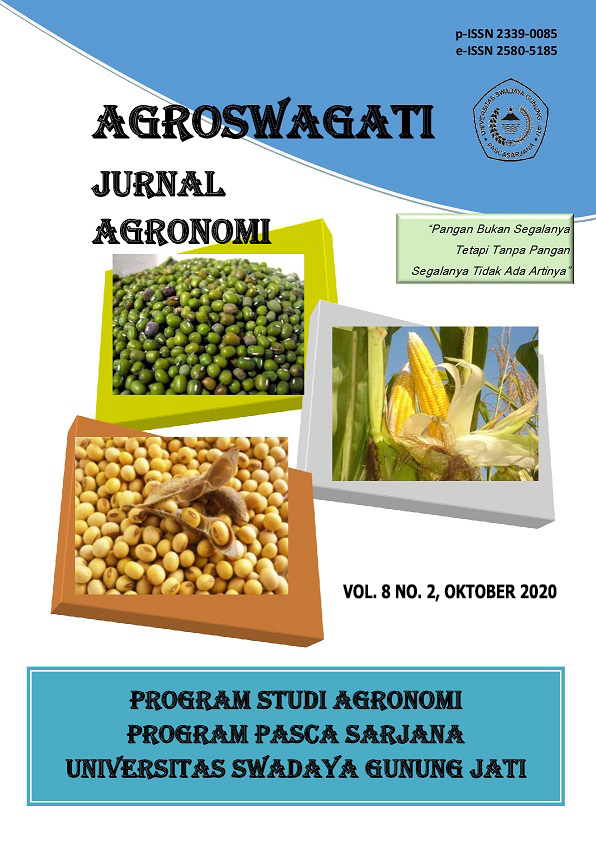EFFECT OF PHOSPHORUS AND SULFUR FERTILIZERS ON GROWTH AND TIELD SHALLOTS (Allium ascalonicum L.) BIMA VARIETY
DOI:
https://doi.org/10.33603/agroswagati.v8i2.4945Kata Kunci:
Growth, Yield, Shallots, Phosphorus and SulfurAbstrak
This study aims to determine: (1) Interaction between phosphorus and sulfur fertilizers on the growth and yield of shallots (Allium ascalonicum L.) Bima variety, (2) Dosage of phosphorus and sulfur fertilizers which have a good effect on growth and yield of shallots (Allium). ascalonicum L.) Bima variety, and (3) The relationship between growth components and yield components of shallots Bima variety. The research was carried out in a rice field area belonging to the UPTD of the Food and Agriculture Security Service in Cisantana Village, Cigugur District, Kuningan Regency, from May to July 2020. The method used in this research is an experimental method, with a randomized block design, factorial pattern, which consists of two treatment factors, namely the factor of phosphorus fertilizer and sulfur fertilizer and repeated three times. The first factor of phosphorus (P) consists of four levels of treatment, namely: p0 (0 kg P2O5/ha), p1 (36 kg P2O0/ha), p2 (54 kg P2O5/ha), and p3 (72 kg P2O5/ha). The second factor of sulfur (S) consists of three levels, namely: s1 (30 kg sulfur/ha), s2 (60 kg sulfur/ha) and s3 (90 kg sulfur/ha). The results showed that: (1) there was an interaction effect between the treatment of phosphorus and sulfur fertilizers on the weight of fresh tubers and dry bulb weight of shallots, (2) phosphorus and sulfur fertilizers independently affected plant height, number of tillers per clump, number of leaves per clumps, root volume, root shoot ratio, relative growth rate, number of tubers and tuber diameter. The dosages of phosphorus fertilizer of 54 kg P2O5/ha and 60 kg sulfur/ha gave the highest fresh tuber weight and dry tuber weight per plot. The dosages of phosphorus fertilizer 54 kg P2O5/ha and 60 kg sulfur/ha give weight of fresh tubers and dry tubers per plot of 6.53 kg and 5.24 kg, equivalent to 21.77 tons / ha and 17.47 tons/ ha, and (3) there is a significant relationship between growth components, yield components with fresh tuber weight and dry tuber weight of Bima variety onion per plot.
Referensi
Baswarsiati, 2009. Teknologi Produksi Benih Bawang Merah dan Beberapa Permasalahannya. Buletin Teknologi dan Informasi Pertanian Vol. 8, BPTP Jawa Timur.
Brown J. dan Caligari D.S. 2008. An Introduction to Plant Breeding. Blackwell Publishing. Oxford.
Direktorat Jenderal Hortikultura. 2012. Membangun Hortikultura berdasar-kan Enam Pilar Pengembangan. Direktorat Jenderal Hortikultura, Departemen Pertanian, Jakarta.
Elli Afrida. 2009. Pengaruh Pemberian Pupuk Fosfat dan Sulfur Terhadap Pertumbuhan dan Produksi Bawang Merah (Allium ascalonicum). Program Studi Agronomi Fakultas Pertanian Universitas Sriwijaya Palembang.
Karim A, Rashid P, Samad R, Karmoker JL. 2014. Effects of phosphorus deficiency on ion transport and its correlation with sugar content and anatomical structure in chickpea (Cicer arietinum L.cv. bari cola-5) seedlings. Dhaka Univ. J. Biol. Sci., 23(2): 157-164.
Mamaril, C.P., P.B. Gonzales, and V.N. Cacnio. 1991. Sulfur management in lowland rice. Paper presented during the International Symposium on the Role of Sulphur, Magnesium and Micronutrients in Balanced Plant Nutrition held at Chengdu, Sichuan, Proc. On April 3-10, 1991.
Sumarni dan Hidayat, 2005. Pengaruh Pemupukan N, P dan K pada Pertumbuhan dan Produksi Bawang Merah Kultivar Sumenep. J. Hort. Vol 5, No. 5.
Sumarni, N., Rosliana R., Basuki R.S., dan Hilman Y. 2012. Tanggap Pertum-buhan Tanaman Bawang Merah terhadap pemupukan Fosfat pada Beberapa Kesuburan Lahan (status P-tanah). J. Hort. 22(2):138-138.
Syarifah Putri Mashtura, Sufardi, dan Syakur. 2013. Pengaruh Pemupukan Phosfat dan Sulfur Terhadap Pertumbuhan dan Serapan Hara Serta Efisiensi Hasil Padi sawah (Oryza sativa L.). Jurnal Manajemen Sumberdaya Lahan. Volume 2, Nomor 3, Juni 2013: hal. 285- 295.
Unduhan
Diterbitkan
Terbitan
Bagian
Lisensi
The Authors submitting a manuscript do so on the understanding that if accepted for publication, copyright of the article shall be assigned to Jurnal AGROSWAGATI, Sekolah Pascasarjana Ilmu Pertanian. Universitas Swadaya Gunung Jati as publisher of the journal. Copyright encompasses rights to reproduce and deliver the article in all form and media, including reprints, photographs, microfilms, and any other similar reproductions, as well as translations.
Jurnal AGROSWAGATI, Universitas Swadaya Gunung Jati and the Editors make every effort to ensure that no wrong or misleading data, opinions or statements be published in the journal. In any way, the contents of the articles and advertisements published in Jurnal AGROSWAGATIare the sole responsibility of their respective authors and advertisers.

